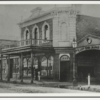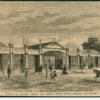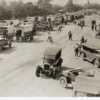The East End Market was Adelaide’s first formal fruit and vegetable market. It operated from the 1860s through to the 1980s on East Terrace, at which point it was closed and a new modern market was opened in Pooraka.
Early Markets in Adelaide
In the first decades of Adelaide’s settlement, there was no officially sanctioned location for agricultural produce to be sold. The bulk of farmers and market-gardeners lived in the Adelaide Hills to the east of the city, and as a result sellers began to congregate on East Terrace. By 1854, the area around the Stag Hotel on the corner of East Terrace and Rundle Street was the epicentre for this trade. Residents and business-owners of this location were not pleased by this situation – the Adelaide Observer gave a scathing assessment stating that:
Near the Stag Inn… is to be found the carcasses of dead cats and dogs, rotting in the sunshine, and decayed vegetable matter of every description, helping to form the gas so fatal to human life. The stench reeking up from this foul bed resembles that of a charnal-house [sic]
By 1859, this situation was generally seen as untenable by locals. In response, the Adelaide Corporation passed a by-law that required the sale of fruit and vegetables to occur in Victoria Square. This decision was very unpopular, and widely ignored. Sellers resented being made to travel into the city centre rather than just the eastern edge, and complained that there were no facilities for selling their goods there. Other residents were upset at the proposed use of public land for private business. A meeting of 60 market gardeners occurred in the Plough and Harrow Hotel on Rundle Street in May of that year, where they requested the construction of a proper marketplace with shelter for their horses. Until this demand was met, they concluded, the by-law compelling the sale of produce in Victoria Square must be flouted.
By 1860, the South Australian Register announced that a proper marketplace was an essential marker of civilisation, and that it was a disgrace that Adelaide lacked such. The Adelaide Corporation did not own any land it thought suitable for such a market, and did not have the required funds to purchase any. The newspaper therefore claimed that the Corporation would ignore the need for a market until ‘the necessities of the city absolutely compel it’ to create one. It pointed out that up to 100 vehicles converged on East Terrace each market day in a confusing mess of buying and selling.
There is some level of confusion as to when the long-standing tradition of growers congregating around the Stag Hotel was officially formalised into what became known as the East End Market. From 1860, a popular spot for traders to set up was the vacant lot owned by Richard Vaughan on East Terrace. This spot was desirable as it was away from the cacophony of the road itself, where latecomers were forced to reside. By 1864, Vaughan was considered the ‘self-constituted clerk of the East-end Market’, a force dominant enough to be able to set prices for goods. In 1866, Vaughan overhauled his empty lot by constructing a building designed to shelter farmers during their hours of sale. As a result, this is usually considered the foundation of the formalised East End Market. In doing so, Vaughan was hailed by Adelaide citizens as a visionary and philanthropist, creating an essential public good when the Adelaide Corporation was unable or unwilling to do the same.
The East End Market
The new market was an instant success. The interior marketplace had a regularised structure, with numbered stands rented out to farmers. As a result, the experience was much easier and safer for purchasers, and sellers were now able to arrive later than previously as they no longer needed to tussle for the prime spots each morning. The facilities also improved for the horses, with ready access to food and water. The market boomed: newspaper reports rave about the range and quality of produce available. Its main content remained fruit and vegetables, but it also sold meats, dairy, toys as well as ‘sugarbeer and other colonial drink’. Normal market hours were the early mornings of Tuesdays, Thursdays and Saturdays, but such was the popularity that the market soon opened Saturday evenings as well, for the crowd less keen on waking up before sunrise. Reports proudly announce that all classes of individuals would shop at the market, including Adelaide’s political and economic elite. The building was expanded in 1869, when it began to compete with the new Central Market in Grote Street.
In 1872, the East End Market was officially sanctioned by the South Australian Government through the passage of the East End Market Act. This Act was openly considered a personal reward for Vaughan, as it gave him authorisation to compulsorily acquire adjacent land to expand the market, even though it was a private enterprise. There was some public apprehension about this, especially from those whose land was likely to be acquired, but it was generally felt that Vaughan’s actions as a private entrepreneur were so beneficial to Adelaide that his plans should be enabled.
So beloved was Vaughan that in 1878 the Adelaide Corporation held a banquet in his honour. Led by the Mayor, this celebration was held to acknowledge how much benefit Adelaide had seen thanks to Vaughan’s private initiative with the East End Market.
By 1899, however, things were beginning to look troubled for the market. Reports circulated that the marketplace was crowded and unsanitary. It was compared unfavourably to the Central Market, as that enterprise banned horses inside the building. In contrast, the East End Market had up to 400 horses standing around directly adjacent to the stalls. The crowded conditions and design pattern of the stalls meant that horses were unable to be removed, and caused significant health concerns with the volume of their manure. The proposed solution to this problem was the purchase of more land.
The New Adelaide Fruit and Produce Exchange
Around 1900 William Charlick, a local fruit vendor, recognised this need for more space. With full occupancy of the East End Market, the overflow still blocked East Terrace on market days. Charlick sought to negotiate sale of his land for an expansion of the market, but the two parties could not come to an agreement. In response to this stalemate, Charlick himself applied for the right to found his own rival marketplace. In 1903, this request was granted and in 1904 Charlick constructed the Adelaide Fruit and Produce Exchange. This new market was built on the site of Peacock’s Tannery, an Adelaide institution for decades, as well as ‘The Rookery’, which was a street of poorly-built and poorly-maintained housing. This new market was much larger, grander, and more modern than the aging East End Market, and soon supplanted it in the public’s mind. It had space for 280 vehicles, compared to the 150 of the original market. The very term ‘East End Market’ soon came to apply equally to the Adelaide Fruit and Produce Exchange than to the actual East End Market itself.
Later Years
While the East End Market continued to operate, it steadily lost ground to the Adelaide Fruit and Produce Exchange in prominence. In 1928, it underwent a grand reopening after being modernised with electric lighting, which was feted as turning the marketplace from a scene of idleness to one of gaiety.
Both of the rival East Terrace markets continued to trade until 1988. The first serious suggestion to move the markets away from the city centre occurred in 1975. A committee was established to examine the practicalities of moving the markets to Northfield. The major concern was that residents complained of a complete inability to find parking around East Terrace on market days. The laws pertaining to the markets allowed for the State Government to compulsorily acquire the properties, but a change in Federal funding meant that this option was soon dismissed. By 1988, however, the State Government had obtained sufficient funding to buy out the land. Modern transportation meant that by this point East Terrace was no longer the most convenient location for farmers to sell their goods. As a result, the markets were shut down and replaced with a new wholesale market at Pooraka. The facades of the markets remain, though the buildings themselves have been demolished and replaced with residential apartment buildings, shops and other businesses.
In 1997, the Minister for Housing and Urban Development commissioned a sculpture by local artist Karen Genoff to represent the history of the former East End Market. This work, titled ‘The Apron’, is a bronze representation of a market apron.







Comments